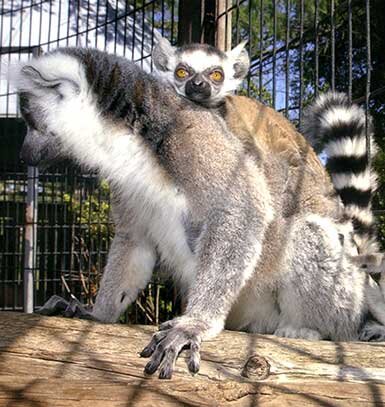ANIMALS OF MADAGASCAR
Madagascar is an island off the coast of Southeast Africa and has one of the largest rain forests in the world. Because of its geographic isolation, Madagascar is home to many amazing animals found nowhere else on Earth. Here are some that reside at Fort Rickey Children’s Discovery Zoo:
TENREC (lesser Hedgehog)
The Lesser Hedgehog Tenrec looks very similar to a Hedgehog, but it actually isn’t even related to a Hedgehog! Oddly enough, Scientists believe the tenrec is more closely related to the elephant, the aardvark, and the manatee. There are 20 recognized types of tenrec, however, scientists have discovered 7 more in recent years. It is unknown how many kinds actually exsist. They are classified as Echinops, the only species in their genus. The Tenrec can be found only in Madagascar.
The Lesser Hedgehog Tenrec has very many similarities with the Hedgehog. They share the same type of diet as omnivores / insectivores, they enjoy feasting on invertebrates, like slugs, as well as snakes, and sometimes even baby mice. They both have poor eye sight, and rely on their strong sense of smell, sensitive whiskers and good hearing. They live solitary lives except in times of mating. And of course, the most noted similarity are the spines covering the back of their bodies for defense against predators. They both will roll into a ball when they feel threatened.
Some of the notable differences include the fact the the Tenrec is arboreal. Meaning it lives mostly in trees. The Hedgehog is mostly a ground dweller and is named after its tendency to forage for bugs under shrubs or “hedges”. A unique behavior found in the Tenrec that the Hedgehog does not display is the ability to go into Torpor. When the temperature lowers the Tenrec will go into a state of torpor. This is similar to hibernation, except that torpor is involuntary and lasts for shorter periods of time. Its essentially a survival tactic to help animals survive winter months. Also, Hedgehogs are primarily nocturnal and the Tenrec is Crepuscular, meaning it is most active at dawn and at dusk.
Tenrecs live 8 to 10 years in the wild and about 13 years in human care. Just as the many unique animals that call Madagascar home, the tenrec species is endangered by habitat destruction.
Mating season: October to November
Gestation: 61-68 days
Litter Size: 5 to 7
This is Humphrey! Our Lesser Tenrec Hedgehog. Currently not on display, he is a “meet and greet animal” and can be seen and even pet during daily presentations.
RING TAILED LEMUR
Ring-tailed lemurs, Lemur catta, are unmistakable because of their long, vividly striped, black-and-white tail. Lemurs use their hands and feet to move nimbly through the trees, but cannot grip with their tails as some of their primate cousins do. Ring-tailed lemurs also spend a lot of time on the ground, which is unusual among lemur species. They forage for fruit, which makes up the greater part of their diet, but also eat leaves, flowers, tree bark, and sap.
They have powerful scent glands and use their unique odor as a communication tool and even as a kind of weapon. Lemurs mark their territory by scent, serving notice of their presence to all who can smell.
Ring-tailed lemurs are endangered, largely because the sparse, dry forests they love are quickly vanishing.
Mating season: May
Gestation: 135-145 days
Litter Size: Usually 1 infant


